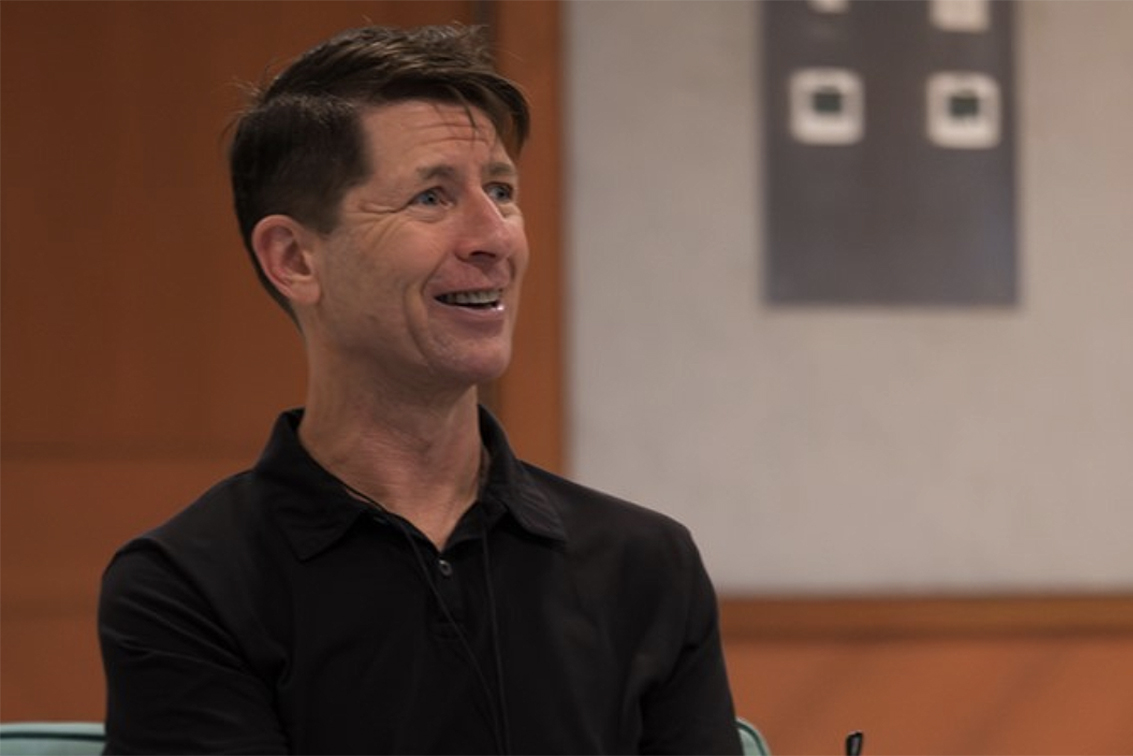AdFest 2024 Grand Jury President and Cheil Worldwide Global CCO, Malcolm Poynton: “We’re in a golden age of creativity so, go for it”

ADFEST 2024 Grand Jury President, Malcolm Poynton, has been recognised as one of the World’s Top 10 Digital Minds by Ad Age. He has led Saatchi & Saatchi, Ogilvy, SapientNitro and Cheil Worldwide to multiple Creative Agency of the Year titles. Since joining Cheil Worldwide as Global Chief Creative Officer in 2015, Poynton’s creative leadership has established the Cheil as one of the world’s leading creative networks, winning Asia Network of the Year, multiple Agency of the Year titles across Hong Kong, China, India, Japan, South Korea and further afield, Spain, Russia and Romania.
Poynton is also Jury President of Effective Lotus, INNOVA Lotus and the inaugural Sustainable Lotus. And as Grand Jury President, he will preside over the Lotus Roots with the other Jury Presidents.
Here he offers a valuable insight into the creative industry and agency life, as well as a behind the scenes exploration of some of the work that made him famous:
What is it about advertising that turns you on? Has that changed over your career?
Poynton said: There is so much to love about advertising – starting with the fact it never stands still. What we do is part of culture so, it’s always evolving and changing as it echoes, amplifies and in some case defines or even shifts culture.
It’s a melting pot of people and thinking from entertainment, art, technology, ethnography, business; global and local perspectives, all wrapped up in one crazy industry that has the ability to change fortunes of businesses as much as it has the ability to enable people in ways never-before thought of.
Advertising has lost some of its gloss as a career. What would you say to/advise young creatives thinking about embarking on their career path?
Poynton: As the advertising industry globalised, it became dominated by holding companies; layers of people came between creatives and clients. When the likes of David Ogilvy, Charles Saatchi and George Lois established their agencies, creatives engaged directly with clients and that shaped great advertising that grew client businesses.
The advice I never hear offered to young creatives entering the industry is to spend as much time as possible with clients. Get to know them, what challenges them and what ambitions they’re looking to realise for their business. Share with them the cost of doing ‘dull’ advertising (there’re hard stats behind this – it’s in creatives’ interest to be interested in this too). Show them what excites and moves people today; use your creative mind to help them get to where their business needs to go, faster.
With the current digital, mobile and AI evolution on top of the power of film, OOH and audio at our fingertips means the industry has never been so creatively rich. We’re in a new golden age of creativity so, go for it.
What does it take to get to the top in a major network agency? What skills/assets have you needed, or developed? Mistakes to own up to?
Poynton: I grew up in a small rural community in Aotearoa New Zealand so, leading a major global network agency is a long way from home. I’d say my journey began at a young age through succeeding in sport; locally, regionally, nationally and then internationally – that gave me a taste for climbing mountains, so to speak.
And when you combine sport and rural Aotearoa, you inherit a no BS attitude to life too. The no-nonsense attitude that came with that has made it easy to stay focussed on the work without getting distracted by the side-shows of larger organisations.
Along the way, I’ve learned not everyone in advertising aspires to do great work, strives to move consumers, to find new answers when clients aren’t convinced or to collaborate with others. The reality is, our world is a lot more complicated than that. The key is to find the balance between patience and determination.
What three pieces of (your) work are you most proud of? Please describe them and explain why? What has been the most important/greatest moment (or moments) in your career?
Poynton: Anyone who follows my social posts will recognise my favourite hashtag: #ThisStuffMatters. I’m passionate about brands making a positive impact. Of course, that can be through brightening people’s lives and fuelling passions just as it can be through innovations that open doors to opportunities and abilities previously beyond reach.
So, perhaps it’s no surprise that the three pieces of work I’m most proud of each make a real difference to people’s lives:
I’d start with Dove’s Campaign For Real Beauty: Besides Nike, I’d say no other brand has had such a positive impact on people and culture, globally. It’s the story behind Campaign For Real Beauty makes me proud on many levels. First, it stemmed from breaking the exclusive ‘female only’ team I discovered working on Dove when I arrived at Ogilvy. Although well-intended, this gender exclusive approach had created a creative echo-chamber; the proof was in the work. Second, despite guidance, the newly appointed male creative lead chose to shoot with a female photographer “for the positive publicity of empowering women”. That got in the way of the idea and the shoot projected everything ‘real beauty’ was not about.
Thankfully, I was then able to convince the team to go with the original recommendation of Rankin, and the rest is history. Well, not quite. This was also the world’s first ad campaign to use a URL as it’s endline: CampaignForRealBeauty.com. This in itself was a game-changer for advertising since every ad – OOH, TV, retail and even packaging opened the door for consumers to engage. Something they did in unprecedented numbers. So, while the industry saw Campaign For Real Beauty as a brand manifesto, it was also the new benchmark for direct response and the birth of ‘participation’ campaigns.
The fact it catapulted Dove from the hygiene category to become a billion-dollar beauty brand, pushing Unilever’s share price north is testimony to the power of creativity. Seeing the campaign continue today with so many new creatives and agencies finding fresh ways to make it relevant to a new generation is even more satisfying.
Next, Foot Locker’s Sneakerpedia. The business challenge behind was immense. Foot Locker was really struggling as the power brands of Nike and adidas pushed further into high street and online retail, taking Foot Locker’s lunch. Stores had over 100% staff churn annually leaving no depth of knowledge on the shop floor, making for a really bad shopping experience. Yet sneakers were having a massive cultural moment. Online and offline ‘zines were popping up all over the place, but nothing opened the door for sneakerheads to share their own crate or collection.
Sneakerpedia joined the dots. It allowed sneaker fans to share their kicks (and the story behind them) and it gave Foot Locker deep insight into the stories behind different sneakers and a heat map of where abouts each kind of sneaker was popular. This revolutionised Foot Locker’s distribution strategy to tailor stock to localised trends, saving huge dead stock and related logistic costs.
With all the new data Sneakerpedia was capturing, we could see kids in Milan were into Indie music, skinny jeans and Converse while kids in Rome were into Rap music and Nike Tuned, so we used that data to build a staff training platform, unlocking all that knowledge for the sales team instore to connect with clients – that changed exponentially the conversion rate. And now sneakerhead’s passions were visible. Foot Locker could press the major brands for exclusive runs that would be sure to sell thanks to the trend insights from Sneakerpedia. Suddenly, the shoe was on the other foot and Foot Locker were no longer at the mercy of the major manufacturers.
The platform was branded Sneakerpedia powered by Foot Locker for the consumers but what we sold to the client was Foot Locker powered by Sneakerpedia. It became one of the four strategic pillars the CEO would use to explain to the stock market how he was going to turn the business around.
More recently, I could mention any number of Samsung campaigns; from Good Vibes, Service Van and Educate the Girl campaigns in India to Dyslexia Dytectiv, Blind Cap, Tallk and Unfear in Spain, Speed Suit or Fast Frame in the Netherlands, Anti-bullying Skin in Brazil or Cost of Bullying and Quest for Dyslexia in China but I’m going to call out a much older project, #BeFearless. This project unlocked a new approach for Cheil WW and sparked the shift from a Samsung’s global platform of Launching People to Do What You Can’t.
Arriving at Cheil WW, I could see how disconnected earlier approaches had been on global projects. At SapientNitro, I’d developed a cross-discipline (writer x art director x creative tech x UXD) collaborative way of working, along with a super-high cadence, x3 day ‘creative sprint’ methodology. By bringing together 10-12 creatives from across disciplines and across the globe, armed with giant polly-boards and sticky pads, I ran creative sprints designed to collaboratively ‘build-upon’ (not tear-down) ideas.
Almost overnight, we were consistently arriving at ideas others simply couldn’t. In this case, it enabled us to develop the first truly ‘useful’ use of VR for consumers. #BeFearless enabled people to become desensitised from their fears, such as public speaking, fear of heights, arachnophobia. And in doing so, it demonstrated to everyone Samsung’s commitment to putting meaningful leaps in mobile technology into the world, to improve the lives of many.
What are the greatest challenges facing advertising right now. What do you think advertising needs to overcome them? Conversely what is working well – where are the opportunities?
Poynton: The biggest challenge the industry faces today is confidence. Confidence in the value of what we offer clients. Confidence in the ability to stay relevant in the face of new technology. Confidence in the power human intelligence.
As a result, holding companies like Publicis are moving towards becoming a tech company in an attempt to get to more revenues. If they do, it could unlock more investment in what they increasingly view as boutique creative agencies. Similar to what we’ve recently seen with Globant investing in Gut. And similar to Cheil’s deep relationship with technology while embracing the power of creativity to make meaningful consumer connections.
So, while everyone’s consumed with the macro shift toward efficiencies tech brings to the industry, creativity will always be the factor that truly changes the fortunes of businesses and positively change the lives of consumers. You cannot ‘tech’ your way to that.
At the end of the day, creative ideas are the cornerstone of all game-changing advertising.
